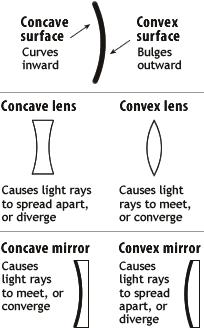Inies, outies…
Concave goes inwards like a cave. Convex goes outwards like your anger. That’s how I always remember it. ![]()
Haha!! I’ll have to remember that! 
Why remember two things? Isn’t it enough to know that convex is a bump and thus concave is the other way (or vice versa)? Doesn’t seem to need a mnemonic or memory aide for but one of the two as the other can be inferred from the first.
Yup. That’s how I remember it. Concave is inward like a cave and convex is the other one.
As @ihermit2 stated, it’s all about perspective. If you’re looking at the container from the outside, the terms will be opposite of what they would be if you were looking at the curves from inside the container.
No it’s not. The surfaces are either concave or convex. The direction is toward the material’s center. A concave surface does not become convex just because I turn it over. There might be a corresponding convex surface on the other side because of the depth of the concavity but the surfaces are not dependent on point of view. It’s either in (towards the middle) or out (away from the middle); it’s not towards/away from the viewer that counts.
Don’t worry, when your Glowforge arrives you can achieve coherent enlightenment.
I’ve always thought of it as this when I first remember reading about it in biology classes in grade school and tackling frog anatomy: me looking out from my eye ball through the lens. The lens will be concave from my perspective. Everyone else looking at my eye would see the lens as convex. Never had any problem after that.
Probably helped that at the same time I got glasses and it was interesting to learn just how they work. Same perspective.
I saw this discussion and couldn’t figure out why it wasn’t obvious to everyone. Then I remembered that I work with lens and mirrors every day and also build telescopes, just because. I’m guessing many of you know the difference between a tibia and a fibula. I don’t.

But from the mountain’s perspective, a cave is a convex pocket of air inside it. (Just being obnoxious.)
My favorite mnemonic for telling PNP and NPN transistors apart is that the arrow is Not Pointing iN for the NPN.
Your first illustration of the curved surface is the point I was trying to make. Viewed from the left sides, it’s a concave surface, but viewed from the right side it’s a convex surface. That’s all I was trying to say 
It would have to be rephrased for teaching the mnemonics to most mineral aggregates.
Where’s the groan button when you need one? ![]()
@rpegg’s mention of fibula vs tibia dredged up this one from Human Anatomy (cadaver lab) for the 12 cranial nerves: “On old Olympus’ towering top, a Finn and Greek viewed some hops.” Don’t remember the actual nerves, but almost 4 decades later, this I remember!
Oh, and the tibia is the thicker weight-bearing one. ![]()
But once you are in the cave you need to figure out the difference of stalagmites and stalactites…
Stalac tites have to hold on tight (So they don’t fall off, see)
Stalag mites are on the ground (and you might trip on one.)
also, in the spelling, with “ct:tc” vs “gm:mg”.
(the “t” in “stala c tite” points up towards the _c_eiling,
while the “g” in “stala g _m_ite” points _m_ore to the ground)
So is a contact lens concave or convex? Seems if it is sitting like a bowl it is concave but like a bump it is convex? 
er, just how old are you?
Overall shape, concave towards the eye, convex away. Refractivity it depends on if you are near or far sighted.